 |
Satish Lele lelepiping@gmail.com |
View this page as YouTube Video Presentation
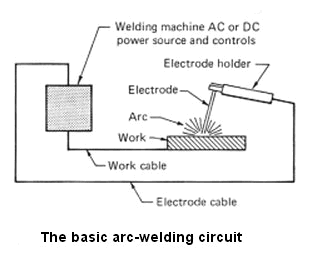
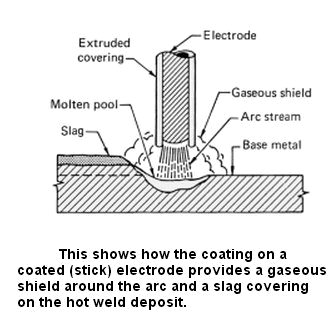
Figure illustrates the shielding of the welding arc and molten pool with a Stick electrode. The extruded covering on the filler metal rod, provides a shielding gas at the point of contact while the slag protects the fresh weld from the air. The arc itself is a very complex phenomenon. In-depth understanding of the physics of the arc is of little value to the welder, but some knowledge of its general characteristics can be useful.
Nature of the Arc: An arc is an electric current flowing between two electrodes through an ionized column of gas. A negatively charged cathode and a positively charged anode create the intense heat of the welding arc. Negative and positive ions are bounced off of each other in the plasma column at an accelerated rate. In welding, the arc not only provides the heat needed to melt the electrode and the base metal, but under certain conditions must also supply the means to transport the molten metal from the tip of the electrode to the work. Several mechanisms for metal transfer exist. Two (of many) examples include:
- Surface Tension Transfer: A drop of molten metal touches the molten metal pool and is drawn into it by surface tension.
- Spray Arc: The drop is ejected from the molten metal at the electrode tip by an electric pinch propelling it to the molten pool (great for overhead welding).
Since there must be an ionized path to conduct electricity across a gap, the mere switching on of the welding current with an electrically cold electrode posed over it will not start the arc. The arc must be ignited. This is caused by either supplying an initial voltage high enough to cause a discharge or by touching the electrode to the work and then withdrawing it as the contact area becomes heated. Arc welding may be done with direct current (DC) with the electrode either positive or negative or alternating current (AC). The choice of current and polarity depends on the process, the type of electrode, the arc atmosphere, and the metal being welded.
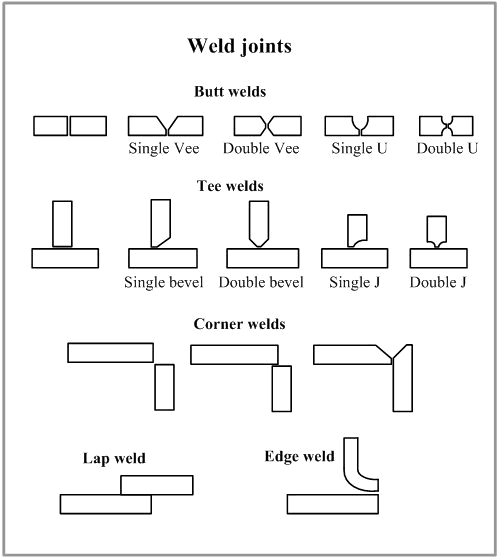
Argon Arc Welding
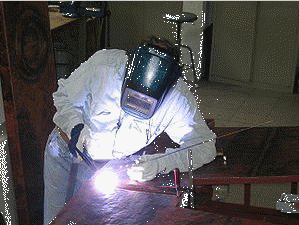
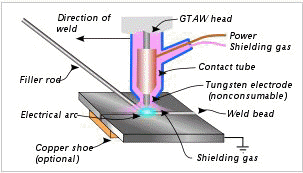
GTAW is most commonly used to weld thin sections of stainless steel and non-ferrous metals such as aluminum, magnesium, and copper alloys. The process grants the operator greater control over the weld than competing processes such as shielded metal arc welding and gas metal arc welding, allowing for stronger, higher quality welds. However, GTAW is comparatively more complex and difficult to master, and furthermore, it is significantly slower than most other welding techniques. A related process, plasma arc welding, uses a slightly different welding torch to create a more focused welding arc and as a result is often automated.
Operation: Manual gas tungsten arc welding is often considered the most difficult of all the welding processes commonly used in industry. Because the welder must maintain a short arc length, great care and skill are required to prevent contact between the electrode and the work piece. Similar to torch welding, GTAW normally requires two hands, since most applications require that the welder manually feed a filler metal into the weld area with one hand while manipulating the welding torch in the other. However, some welds combining thin materials (known as autogenous or fusion welds) can be accomplished without filler metal; most notably edge, corner, and butt joints.
To strike the welding arc, a high frequency generator (similar to a Tesla coil) provides an electric spark; this spark is a conductive path for the welding current through the shielding gas and allows the arc to be initiated while the electrode and the work piece are separated, typically about 1.5–3 mm apart. This high voltage, high frequency burst can be damaging to some vehicle electrical systems and electronics, because induced voltages on vehicle wiring can also cause small conductive sparks in the vehicle wiring or within semiconductor packaging. Vehicle 12V power may conduct across these ionized paths, driven by the high-current 12V vehicle battery. These currents can be sufficiently destructive as to disable the vehicle; thus the warning to disconnect the vehicle battery power from both +12 and ground before using welding equipment on vehicles.
An alternate way to initiate the arc is the "scratch start". Scratching the electrode against the work with the power on also serves to strike an arc, in the same way as SMAW ("stick") arc welding. However, scratch starting can cause contamination of the weld and electrode. Some GTAW equipment is capable of a mode called "touch start" or "lift arc"; here the equipment reduces the voltage on the electrode to only a few volts, with a current limit of one or two amps (well below the limit that causes metal to transfer and contamination of the weld or electrode). When the GTAW equipment detects that the electrode has left the surface and a spark is present, it immediately (within microseconds) increases power, converting the spark to a full arc.
Once the arc is struck, the welder moves the torch in a small circle to create a welding pool, the size of which depends on the size of the electrode and the amount of current. While maintaining a constant separation between the electrode and the work piece, the operator then moves the torch back slightly and tilts it backward about 10–15 degrees from vertical. Filler metal is added manually to the front end of the weld pool as it is needed.
Welders often develop a technique of rapidly alternating between moving the torch forward (to advance the weld pool) and adding filler metal. The filler rod is withdrawn from the weld pool each time the electrode advances, but it is never removed from the gas shield to prevent oxidation of its surface and contamination of the weld. Filler rods composed of metals with low melting temperature, such as aluminum, require that the operator maintain some distance from the arc while staying inside the gas shield. If held too close to the arc, the filler rod can melt before it makes contact with the weld puddle. As the weld nears completion, the arc current is often gradually reduced to allow the weld crater to solidify and prevent the formation of crater cracks at the end of the weld.
Applications: While the aerospace industry is one of the primary users of gas tungsten arc welding, the process is used in a number of other areas. Many industries use GTAW for welding thin work pieces, especially nonferrous metals. It is used extensively in the manufacture of space vehicles, and is also frequently employed to weld small-diameter, thin-wall tubing such as those used in the bicycle industry. In addition, GTAW is often used to make root or first pass welds for piping of various sizes. In maintenance and repair work, the process is commonly used to repair tools and dies, especially components made of aluminum and magnesium.
Because the weld metal is not transferred directly across the electric arc like most open arc welding processes, a vast assortment of welding filler metal is available to the welding engineer. In fact, no other welding process permits the welding of so many alloys in so many product configurations. Filler metal alloys, such as elemental aluminum and chromium, can be lost through the electric arc from volatilization. This loss does not occur with the GTAW process. Because the resulting welds have the same chemical integrity as the original base metal or match the base metals more closely, GTAW welds are highly resistant to corrosion and cracking over long time periods, GTAW is the welding procedure of choice for critical welding operations like sealing spent nuclear fuel canisters before burial.
Shielding Gas: As with other welding processes such as gas metal arc welding, shielding gases are necessary in GTAW to protect the welding area from atmospheric gases such as nitrogen and oxygen, which can cause fusion defects, porosity, and weld metal embrittlement if they come in contact with the electrode, the arc, or the welding metal. The gas also transfers heat from the tungsten electrode to the metal, and it helps start and maintain a stable arc.
Argon-helium mixtures are also frequently utilized in GTAW, since they can increase control of the heat input while maintaining the benefits of using argon. Normally, the mixtures are made with primarily helium (often about 75% or higher) and a balance of argon. These mixtures increase the speed and quality of the AC welding of aluminum, and also make it easier to strike an arc. Another shielding gas mixture, argon-hydrogen, is used in the mechanized welding of light gauge stainless steel, but because hydrogen can cause porosity, its uses are limited. Similarly, nitrogen can sometimes be added to argon to help stabilize the austenite in austentitic stainless steels and increase penetration when welding copper. Due to porosity problems in ferritic steels and limited benefits, however, it is not a popular shielding gas additive.
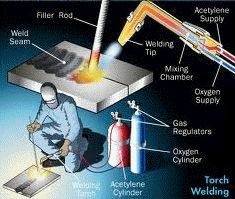
Gas Welding Basics: Gas welding operations center on a torch that creates the welding flame. The welder can adjust the amount of gas being used by the torch and the oxygen used to feed the flame. By controlling the ratio of the gas and oxygen, the welder can create different flames with different characteristics, depending on the material being welded. The welder uses a filler rod coated with flux to add material to the weld and to displace the air from the weld location. Like all welding processes, the welder must wear protective clothing, including a welding mask, gloves, and coverall clothing.
Gases Used for Welding Fuel: Before acetylene could be effectively produced and contained, coal gas and hydrogen were used for gas welding. Today, gas welding is performed using propane, MAPP, gasoline, and hydrogen. Oxy-acetylene is the most common gas combination used in gas welding operations. Oxy-acetylene welding combines oxygen gas and acetylene gas to create the flame. Acetylene provides the hottest flame of all gas welding fuels, and can therefore be used to weld or cut thicker materials. However, acetylene is more expensive than most welding fuel gases.
Welding Rods: Gas welding uses welding rods to introduce filler material into a weld. Welding rods for gas welding are coated with a flux material that vaporizes when heated. The vaporized flux displaces air from the weld location so that oxides are not included in the weld. Welding rods are available in a variety of materials to match the material of the work pieces being welded.
Pros and Cons of Gas Welding: No electricity is required to perform gas welding, so these systems are portable and can be used in remote locations that do not have electrical sources. However, the gases used for this type of welding are combustible and they must be stored and handled properly. Gas welding does not produce as much localized heat as arc welding, and the quality of welds created by arc welding have resulted in the decline of gas welding as the primary welding process. However, gas welding does still remain an important part of welding and fabrication shops.
 to get all the information as a eBook
to get all the information as a eBook
